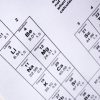Silicon, another semiconductor traditionally employed in photovoltaics, has also been used in less-efficient photoelectrochemical cells (2.5-8 percent so far), but they can be significantly less expensive than the gallium-based cells due to the abundance of silicon. The Si-based devices developed up to this point use the semiconductor surface as a catalyst, but this setup also requires an extremely basic solution—so these suffer the same stability problems over time. To this end, the authors of the current paper integrated a silicon-based photoelectrochemical cell with a cobalt-phosphate (Co-Pi) catalyst that can operate in a neutral pH solution. In addition to avoiding the degrading properties of a high-pH environment, the cobalt-based catalyst is inexpensive compared to a traditional platinum catalyst. The Co-Pi catalyst acts like—and is structurally similar to—the oxygen-evolving (or water-splitting) complex (OEC), the enzyme used in photosynthesis to break down water. Like the OEC, it also exhibits high activity at room temperature in both seawater and fresh water, and operates under neutral pH conditions. This means that, unlike the previous designs, this device doesn’t run into any stability problems over time. When combined with an np-Si junction, the catalyst can increase the efficiency of photoelectrochemical water splitting. We’ve covered this catalyst before being used with zinc oxide, but this is the first demonstration with silicon. This device in its current configuration looks like a sandwich: a 10 μm photoresist, a 140 nm patterned metal contact (Ti/Pd/Ag), n-type Si, p-type Si, a 1.5 nm SiO2 interface, a 50 nm indium tin oxide (ITO) protective layer, and the Co-Pi catalyst film. The photoresist on the n-side protects the metal contacts and silicon from water, while the ITO layer on the p-side protects the silicon from water that penetrates the catalyst. The sunlight or artificial illumination hits the n-side, passing through the photoresist. The primary result of this paper (other than demonstration of the new catalyst integrated with a silicon cell) is that most of the generated potential was used towards the water splitting. As a proof-of-concept, this device is promising, but significant effort will still be needed to develop this concept into a functioning photoelectrochemical cell. PNAS, 2011. DOI: 10.1073/pnas.1106545108 (About DOIs). (via Clean, cheap hydrogen production from water using cobalt catalyst)
